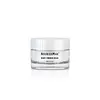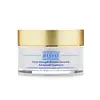What's inside
What's inside
 Key Ingredients
Key Ingredients

 Benefits
Benefits

 Concerns
Concerns

 Ingredients Side-by-side
Ingredients Side-by-side

Water
Skin ConditioningGlycerin
HumectantPropanediol
SolventCetearyl Alcohol
EmollientCetyl Alcohol
EmollientDimethicone
EmollientEthyl Macadamiate
Skin ConditioningCaprylyl Methicone
Skin ConditioningPvp
Emulsion StabilisingPolysorbate 20
EmulsifyingGlyceryl Caprylate
EmollientSteareth-100/PEG-136/Hdi Copolymer
Cereus Grandiflorus Flower Extract
Skin ConditioningMalus Domestica Fruit Extract
AntioxidantZingiber Officinale Extract
Skin ConditioningHydrolyzed Collagen
EmollientAvena Sativa Kernel Extract
AbrasivePalmitoyl Tripeptide-1
Skin ConditioningPalmitoyl Tetrapeptide-7
Skin ConditioningAcetyl Hexapeptide-8
HumectantCetearyl Glucoside
EmulsifyingButylene Glycol
HumectantSqualane
EmollientPEG-12 Dimethicone/PPG-20 Crosspolymer
Sclerotium Gum
Emulsion StabilisingLysolecithin
EmulsifyingCanola Oil
EmollientPullulan
Xanthan Gum
EmulsifyingCarbomer
Emulsion StabilisingHydroxyethyl Acrylate/Sodium Acryloyldimethyl Taurate Copolymer
Emulsion StabilisingParfum
MaskingPotassium Sorbate
PreservativePhenoxyethanol
PreservativeEthylhexylglycerin
Skin ConditioningCI 17200
Cosmetic ColorantCI 19140
Cosmetic ColorantWater, Glycerin, Propanediol, Cetearyl Alcohol, Cetyl Alcohol, Dimethicone, Ethyl Macadamiate, Caprylyl Methicone, Pvp, Polysorbate 20, Glyceryl Caprylate, Steareth-100/PEG-136/Hdi Copolymer, Cereus Grandiflorus Flower Extract, Malus Domestica Fruit Extract, Zingiber Officinale Extract, Hydrolyzed Collagen, Avena Sativa Kernel Extract, Palmitoyl Tripeptide-1, Palmitoyl Tetrapeptide-7, Acetyl Hexapeptide-8, Cetearyl Glucoside, Butylene Glycol, Squalane, PEG-12 Dimethicone/PPG-20 Crosspolymer, Sclerotium Gum, Lysolecithin, Canola Oil, Pullulan, Xanthan Gum, Carbomer, Hydroxyethyl Acrylate/Sodium Acryloyldimethyl Taurate Copolymer, Parfum, Potassium Sorbate, Phenoxyethanol, Ethylhexylglycerin, CI 17200, CI 19140
Water
Skin ConditioningGlycerin
HumectantCaprylic/Capric Triglyceride
MaskingSimmondsia Chinensis Seed Oil
EmollientButylene Glycol
HumectantGlycereth-26
HumectantSqualane
EmollientStearyl Olivate
EmollientOctyldodecyl Olivate
Skin ConditioningDi-C12-15 Alkyl Fumarate
EmollientDimethicone
EmollientStearic Acid
CleansingPalmitoyl Tripeptide-38
Skin ConditioningPalmitoyl Heptapeptide-5
Skin ConditioningPalmitoyl Tetrapeptide-7
Skin ConditioningPalmitoyl Oligopeptide
CleansingPantothenic Acid/Yeast Polypeptide
Skin ConditioningRhododendron Ferrugineum Leaf Cell Culture Extract
Skin ConditioningGlobularia Cordifolia Callus Culture Extract
Skin ConditioningFoeniculum Vulgare Fruit Extract
EmollientHumulus Lupulus Extract
AntimicrobialMelissa Officinalis Leaf Extract
Skin ConditioningViscum Album Leaf Extract
SoothingChamomilla Recutita Flower Extract
MaskingAchillea Millefolium Extract
CleansingGlycine Soja Sterols
EmollientAdenosine
Skin ConditioningUrea
BufferingAllantoin
Skin ConditioningDipotassium Glycyrrhizate
HumectantSodium Hyaluronate
HumectantHydroxypropyl Cyclodextrin
MaskingCoco-Glucoside
CleansingMica
Cosmetic ColorantTitanium Dioxide
Cosmetic ColorantIron Oxides
Lecithin
EmollientSodium Benzoate
MaskingLactic Acid
BufferingPolysorbate 60
EmulsifyingCarbomer
Emulsion StabilisingPolysorbate 20
EmulsifyingPolymethyl Methacrylate
Hydroxyethyl Acrylate/Sodium Acryloyldimethyl Taurate Copolymer
Emulsion StabilisingHydrogenated Lecithin
EmulsifyingDimethiconol
EmollientPolyglyceryl-10 Distearate
EmulsifyingTocopheryl Acetate
AntioxidantArginine
MaskingCitrus Paradisi Peel Extract
PerfumingHydroxypropyl Bislauramide Mea
EmollientLactic Acid/Glycolic Acid Copolymer
Skin ConditioningDextran
Disodium EDTA
Isomalt
HumectantPhenoxyethanol
PreservativeEthylhexylglycerin
Skin ConditioningWater, Glycerin, Caprylic/Capric Triglyceride, Simmondsia Chinensis Seed Oil, Butylene Glycol, Glycereth-26, Squalane, Stearyl Olivate, Octyldodecyl Olivate, Di-C12-15 Alkyl Fumarate, Dimethicone, Stearic Acid, Palmitoyl Tripeptide-38, Palmitoyl Heptapeptide-5, Palmitoyl Tetrapeptide-7, Palmitoyl Oligopeptide, Pantothenic Acid/Yeast Polypeptide, Rhododendron Ferrugineum Leaf Cell Culture Extract, Globularia Cordifolia Callus Culture Extract, Foeniculum Vulgare Fruit Extract, Humulus Lupulus Extract, Melissa Officinalis Leaf Extract, Viscum Album Leaf Extract, Chamomilla Recutita Flower Extract, Achillea Millefolium Extract, Glycine Soja Sterols, Adenosine, Urea, Allantoin, Dipotassium Glycyrrhizate, Sodium Hyaluronate, Hydroxypropyl Cyclodextrin, Coco-Glucoside, Mica, Titanium Dioxide, Iron Oxides, Lecithin, Sodium Benzoate, Lactic Acid, Polysorbate 60, Carbomer, Polysorbate 20, Polymethyl Methacrylate, Hydroxyethyl Acrylate/Sodium Acryloyldimethyl Taurate Copolymer, Hydrogenated Lecithin, Dimethiconol, Polyglyceryl-10 Distearate, Tocopheryl Acetate, Arginine, Citrus Paradisi Peel Extract, Hydroxypropyl Bislauramide Mea, Lactic Acid/Glycolic Acid Copolymer, Dextran, Disodium EDTA, Isomalt, Phenoxyethanol, Ethylhexylglycerin
Ingredients Explained
These ingredients are found in both products.
Ingredients higher up in an ingredient list are typically present in a larger amount.
Butylene Glycol (or BG) is used within cosmetic products for a few different reasons:
Overall, Butylene Glycol is a safe and well-rounded ingredient that works well with other ingredients.
Though this ingredient works well with most skin types, some people with sensitive skin may experience a reaction such as allergic rashes, closed comedones, or itchiness.
Learn more about Butylene GlycolCarbomer is a polymer of acrylic acid. Its main role is to create a gel consistency.
A high amount of carbomer can cause pilling or balling up of products. Don't worry, most products contain 1% or less of carbomer.
Dimethicone is a type of synthetic silicone created from natural materials such as quartz.
What it does:
Dimethicone comes in different viscosities:
Depending on the viscosity, dimethicone has different properties.
Ingredients lists don't always show which type is used, so we recommend reaching out to the brand if you have questions about the viscosity.
This ingredient is unlikely to cause irritation because it does not get absorbed into skin. However, people with silicone allergies should be careful about using this ingredient.
Note: Dimethicone may contribute to pilling. This is because it is not oil or water soluble, so pilling may occur when layered with products. When mixed with heavy oils in a formula, the outcome is also quite greasy.
Learn more about DimethiconeEthylhexylglycerin (we can't pronounce this either) is commonly used as a preservative and skin softener. It is derived from glyceryl.
You might see Ethylhexylglycerin often paired with other preservatives such as phenoxyethanol. Ethylhexylglycerin has been found to increase the effectiveness of these other preservatives.
Glycerin is already naturally found in your skin. It helps moisturize and protect your skin.
A study from 2016 found glycerin to be more effective as a humectant than AHAs and hyaluronic acid.
As a humectant, it helps the skin stay hydrated by pulling moisture to your skin. The low molecular weight of glycerin allows it to pull moisture into the deeper layers of your skin.
Hydrated skin improves your skin barrier; Your skin barrier helps protect against irritants and bacteria.
Glycerin has also been found to have antimicrobial and antiviral properties. Due to these properties, glycerin is often used in wound and burn treatments.
In cosmetics, glycerin is usually derived from plants such as soybean or palm. However, it can also be sourced from animals, such as tallow or animal fat.
This ingredient is organic, colorless, odorless, and non-toxic.
Glycerin is the name for this ingredient in American English. British English uses Glycerol/Glycerine.
Learn more about GlycerinThis is a synthetic polymer. It helps improve the texture of products by adding thickness and gel-like feel.
It is also an emulsifer, meaning it prevents ingredients such as oil and water from separating. It also helps evenly disperse other ingredients.
Palmitoyl Tetrapeptide-7 (formerly Palmitoyl Tetrapeptide-3) is a lab-made peptide with anti-inflammatory and skin-repairing benefits. It's made up of four amino acids (glycine, glutamine, proline, and arginine) and palmitic acid (which helps it penetrate skin more effectively).
This ingredient helps reduce inflammation by limiting the production of interleukin-6 (IL-6), a chemical that triggers inflammatory responses, particularly after UV exposure.
Less inflammation = slower collagen breakdown and a longer-lasting, youthful appearance.
Palmitoyl Tetrapeptide-7 also stimulates collagen production and supports a healthier skin barrier.
Over time, this can improve skin firmness, hydration, and reduce the appearance of fine lines. It’s commonly paired with Palmitoyl Tripeptide-1 in the well-known Matrixyl 3000 complex for enhanced anti-aging effects.
This ingredient has been shown to be effective and safe in cosmetic use and you'll typically find it in small amounts (less than 0.01%).
Due to its palmitic acid base, it may not be safe for Malassezia folliculitis.
Read more about other common types of peptides here:
Learn more about Palmitoyl Tetrapeptide-7Phenoxyethanol is a preservative that has germicide, antimicrobial, and aromatic properties. Studies show that phenoxyethanol can prevent microbial growth. By itself, it has a scent that is similar to that of a rose.
It's often used in formulations along with Caprylyl Glycol to preserve the shelf life of products.
Polysorbate 20 is made by combining ethoxylation of sorbitan, ethylene oxide, and lauric acid. It is a mild cleansing agent, surfactant, and emulsifier.
As a surfactant, it helps collect dirt and oils for washing. Emulsifiers prevent oils and water from separating.
Polysorbate 20 also adds scent to a product. Since it is made using sorbitol, it has a sweet scent. Sorbitol can also be found in fruits such as apples and peaches.
The lauric acid used to create Polysorbate 20 is often derived from coconuts.
Polysorbate 20 may not be fungal acne safe.
Learn more about Polysorbate 20Squalane is an emollient that helps the skin hold onto moisture. It's an oily liquid that occurs naturally in certain types of fish and plant oils.
Because squalane boosts hydration in the skin, it also comes with plenty of benefits: it is an antioxidant and can help fight free radicals and skin damage. Squalane is also found to have a detoxifying effect when applied.
Squalane comes from squalene, which occurs naturally within the sebum of our skin. It is one of the oils our skin produces to keep itself hydrated. Squalane is the hydrogenated version of squalene and has a longer shelf life.
Research shows that squalane is non-irritating (even at 100% concentration).
In general, it's a fantastic ingredient. It does a great job at hydrating the skin, and it's suitable for those with sensitive skin.
The source of squalane may impact malassezia / fungal acne. This is because olive oil derived squalane can contain impurities such as fatty acids and plant waxes. Sugarcane derived squalane is recommended for anyone with malassezia concerns.
Is squalane vegan?
This depends on the source. Squalane can be derived from both plants and animals. Most squalane used in skincare comes from plants.
Please note: the source of squalane is only known if disclosed by the brand. We recommend reaching out to the brand if you have any questions about their squalane.
Read more about squalene with an "e".
Is squalane an oil?
Squalane is often called an oil, but it’s technically not; it’s a hydrocarbon, meaning it’s only made of carbon and hydrogen, unlike true oils which are triglycerides made of fatty acids and glycerol.
The term “oil-free” isn’t regulated, so companies can define it however they want. Some exclude all oils, while others just avoid mineral oil or comedogenic oils.
While some people avoid oils thinking they cause breakouts, the right kind of oil (or oil-like ingredient like squalane) can actually help balance and hydrate your skin. It’s worth testing out simple oils or squalane to see what works best for your skin.
Learn more about SqualaneWater. It's the most common cosmetic ingredient of all. You'll usually see it at the top of ingredient lists, meaning that it makes up the largest part of the product.
So why is it so popular? Water most often acts as a solvent - this means that it helps dissolve other ingredients into the formulation.
You'll also recognize water as that liquid we all need to stay alive. If you see this, drink a glass of water. Stay hydrated!
Learn more about Water